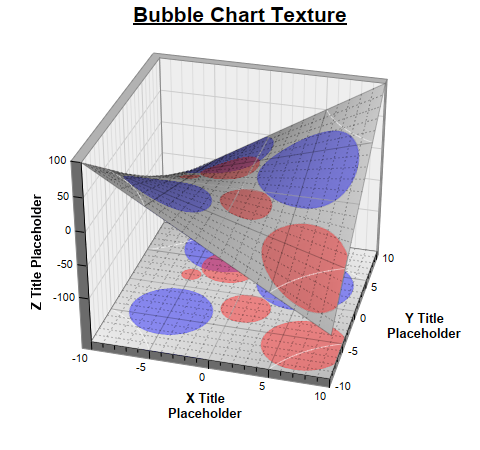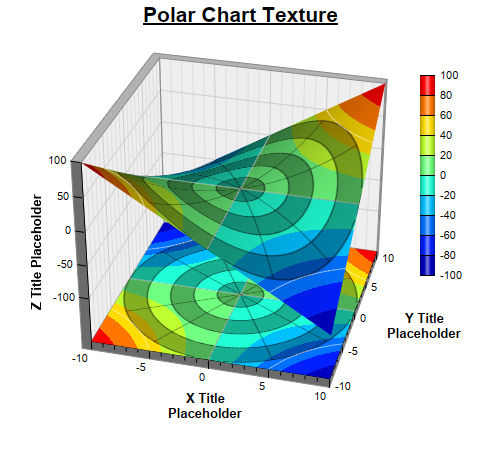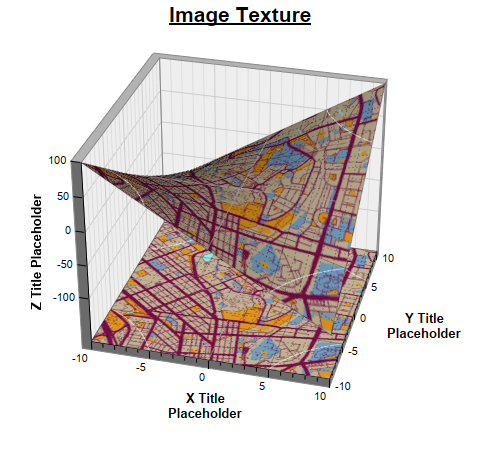The following is the command line version of the code in "cppdemo/surfacetexture". The MFC version of the code is in "mfcdemo/mfcdemo". The Qt Widgets version of the code is in "qtdemo/qtdemo". The QML/Qt Quick version of the code is in "qmldemo/qmldemo".
#include "chartdir.h"
// Use a bubble chart as the surface texture
void addBubbleTexture(SurfaceChart* sc)
{
// Set the original surface color to be from grey (0xbbbbbb) to light grey (0xeeeeee) based on
// the z-value. This will become the background color of the surface.
int colorGradient[] = {0xbbbbbb, 0xeeeeee};
sc->colorAxis()->setColorGradient(true, IntArray(colorGradient, 2));
// The data values for the red bubbles
double dataX0[] = {-5, -2, 1, 7};
const int dataX0_size = (int)(sizeof(dataX0)/sizeof(*dataX0));
double dataY0[] = {2, 4, -2, -6};
const int dataY0_size = (int)(sizeof(dataY0)/sizeof(*dataY0));
double dataZ0[] = {20, 60, 50, 85};
const int dataZ0_size = (int)(sizeof(dataZ0)/sizeof(*dataZ0));
// The data values for the blue bubbles
double dataX1[] = {5, -5, -3};
const int dataX1_size = (int)(sizeof(dataX1)/sizeof(*dataX1));
double dataY1[] = {3, -4, 7};
const int dataY1_size = (int)(sizeof(dataY1)/sizeof(*dataY1));
double dataZ1[] = {100, 85, 95};
const int dataZ1_size = (int)(sizeof(dataZ1)/sizeof(*dataZ1));
// Create a bubble chart of the same size as the surface XY size
XYChart* c = new XYChart(sc->getPlotRegionWidth(), sc->getPlotRegionDepth(), Chart::Transparent)
;
c->setPlotArea(0, 0, c->getWidth(), c->getHeight(), -1, -1, Chart::Transparent,
Chart::Transparent);
// Synchronize the bubble chart axis scale to the surface axis scale. As the surface axes are
// visible, we can hide the bubble chart axes.
c->yAxis()->syncAxis(sc->yAxis());
c->xAxis()->syncAxis(sc->xAxis());
c->xAxis()->setColors(Chart::Transparent);
c->yAxis()->setColors(Chart::Transparent);
// Add bubbles with the semi-transparent red color (0x7fff3333). Also add a matching legend
// entry to the surface chart.
c->addScatterLayer(DoubleArray(dataX0, dataX0_size), DoubleArray(dataY0, dataY0_size), "",
Chart::CircleSymbol, 9, 0x7fff3333, 0x7fff3333)->setSymbolScale(DoubleArray(dataZ0,
dataZ0_size));
sc->getLegend()->addKey("Hot Zone", 0x7fff3333);
// Add bubbles with the semi-transparent blue color (0x7f3333ff). Also add a matchine legend
// entry to the surface chart
c->addScatterLayer(DoubleArray(dataX1, dataX1_size), DoubleArray(dataY1, dataY1_size), "",
Chart::CircleSymbol, 9, 0x7f3333ff, 0x7f3333ff)->setSymbolScale(DoubleArray(dataZ1,
dataZ1_size));
sc->getLegend()->addKey("Wet Zone", 0x7f3333ff);
// Before we generate the bubble chart as texture, we must layout the surface chart first. It is
// because the bubble chart axis scale depends on the surface chart axis scale.
sc->layout();
// Output the bubble chart and save it as a resource
sc->setResource("texture", c->makeChart());
// Use the resource as the texture
sc->setSurfaceTexture(sc->patternColor("@/texture"));
//free up resources
delete c;
}
// Use a polar chart as the surface texture
void addPolarTexture(SurfaceChart* sc)
{
sc->setSurfaceAxisGrid(Chart::Transparent, Chart::Transparent);
PolarChart* c = new PolarChart(sc->getPlotRegionWidth(), sc->getPlotRegionDepth(),
Chart::Transparent);
c->setPlotArea(c->getWidth() / 2, c->getHeight() / 2, c->getWidth() / 2);
// Use alternative light grey/dark grey circular background color
c->setPlotAreaBg(0xaf000000, Chart::Transparent);
// Set the grid style to circular grid
c->setGridStyle(false);
// Set angular axis as 0 - 360, with a spoke every 30 units
c->angularAxis()->setLinearScale(0, 360, 30);
c->angularAxis()->setLabelStyle("normal", 8, Chart::Transparent);
c->radialAxis()->setLinearScale(0, 10, 2);
c->radialAxis()->setColors(Chart::Transparent, Chart::Transparent);
// Output the polar chart and save it as a resource
sc->setResource("texture", c->makeChart());
// Use the resource as the texture
sc->setSurfaceTexture(sc->patternColor("@/texture"));
//free up resources
delete c;
}
void createChart(int chartIndex, const char *filename)
{
// The x and y coordinates of the grid
double dataX[] = {-10, -9, -8, -7, -6, -5, -4, -3, -2, -1, 0, 1, 2, 3, 4, 5, 6, 7, 8, 9, 10};
const int dataX_size = (int)(sizeof(dataX)/sizeof(*dataX));
double dataY[] = {-10, -9, -8, -7, -6, -5, -4, -3, -2, -1, 0, 1, 2, 3, 4, 5, 6, 7, 8, 9, 10};
const int dataY_size = (int)(sizeof(dataY)/sizeof(*dataY));
// The values at the grid points. In this example, we will compute the values using the formula
// z = x * y.
const int dataZ_size = dataX_size * dataY_size;
double dataZ[dataZ_size];
for(int yIndex = 0; yIndex < dataY_size; ++yIndex) {
for(int xIndex = 0; xIndex < dataX_size; ++xIndex) {
dataZ[yIndex * dataX_size + xIndex] = dataX[xIndex] * dataY[yIndex];
}
}
// Create a SurfaceChart object of size 480 x 450 pixels
SurfaceChart* c = new SurfaceChart(480, 450);
// Set the center of the plot region at (240, 210), and set width x depth x height to 240 x 240
// x 200 pixels
c->setPlotRegion(240, 210, 240, 240, 200);
// Set the elevation and rotation angles to 30 and 15 degrees
c->setViewAngle(30, 15);
// Set the data to use to plot the chart
c->setData(DoubleArray(dataX, dataX_size), DoubleArray(dataY, dataY_size), DoubleArray(dataZ,
dataZ_size));
// Spline interpolate data to a 80 x 80 grid for a smooth surface
c->setInterpolation(80, 80);
// Reserve 50 pixels at the bottom of the z-axis to allow for the XY projection
c->zAxis()->setMargin(0, 50);
// Add XY projection
c->addXYProjection();
// Use semi-transparent black (0xc0000000) for x and y major surface grid lines. Use dotted
// style for x and y minor surface grid lines.
int majorGridColor = 0xc0000000;
int minorGridColor = c->dashLineColor(majorGridColor, Chart::DotLine);
c->setSurfaceAxisGrid(majorGridColor, majorGridColor, minorGridColor, minorGridColor);
// Get the surface texture
BaseChart* textureChart = 0;
if (chartIndex == 0) {
// Surface texture is a bubble chart
c->addTitle("<*underline=2*>Bubble Chart Texture", "Arial Bold", 16);
// This texture uses the legend box, so we need to add a legend box to the chart at (490,
// 200).
LegendBox* b = c->addLegend(490, 200, true, "Arial Bold", 10);
b->setBackground(Chart::Transparent, Chart::Transparent);
b->setMaxWidth(c->getWidth() - 490 - 1);
// Add the texture
addBubbleTexture(c);
} else if (chartIndex == 1) {
// Surface Texture is a polar chart
c->addTitle("<*underline=2*>Polar Chart Texture", "Arial Bold", 16);
// This texture uses the color axis, so we add the color axis at (420, 75)
ColorAxis* cAxis = c->setColorAxis(420, 75, Chart::TopLeft, 200, Chart::Right);
// By default, the color axis synchronizes with the z-axis. We cancel the synchronization so
// that the color axis will auto-scale independently.
cAxis->syncAxis(0);
// Add the texture
addPolarTexture(c);
} else {
// Surface Texture is an image
c->addTitle("<*underline=2*>Image Texture", "Arial Bold", 16);
// Use a DrawArea to load the image
DrawArea* d = new DrawArea();
d->load("maptexture.png");
d->resize(c->getPlotRegionWidth(), c->getPlotRegionDepth());
// Set the DrawArea as a resource
c->setResource("texture", d);
// Use the resource as the texture
c->setSurfaceTexture(c->patternColor("@/texture"));
delete d;
}
// Set contour lines to semi-transparent white (80ffffff)
c->setContourColor(0x80ffffff);
// Set the x, y and z axis titles using 10 pt Arial Bold font
c->xAxis()->setTitle("X Title<*br*>Placeholder", "Arial Bold", 10);
c->yAxis()->setTitle("Y Title<*br*>Placeholder", "Arial Bold", 10);
c->zAxis()->setTitle("Z Title Placeholder", "Arial Bold", 10);
// Output the chart
c->makeChart(filename);
//free up resources
delete c;
}
int main(int argc, char *argv[])
{
createChart(0, "surfacetexture0.png");
createChart(1, "surfacetexture1.png");
createChart(2, "surfacetexture2.png");
return 0;
}
© 2023 Advanced Software Engineering Limited. All rights reserved.


